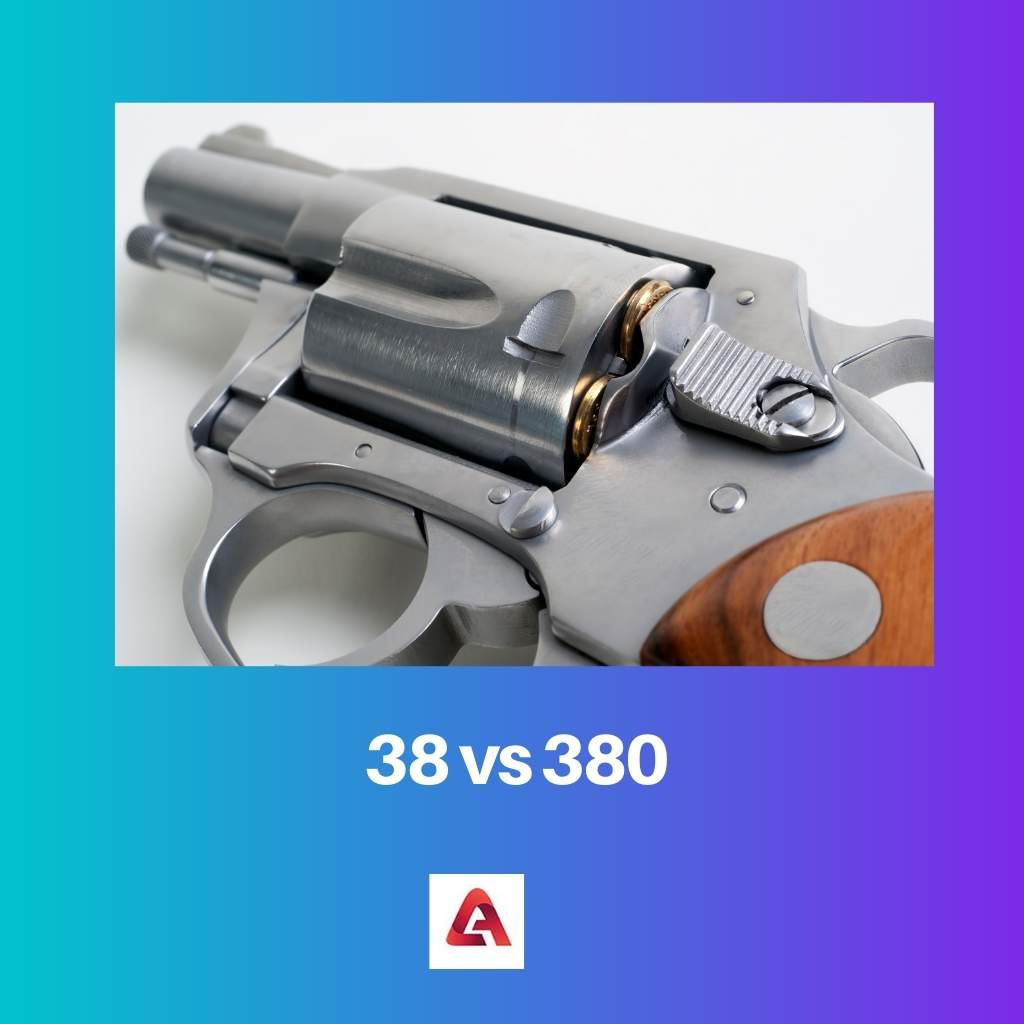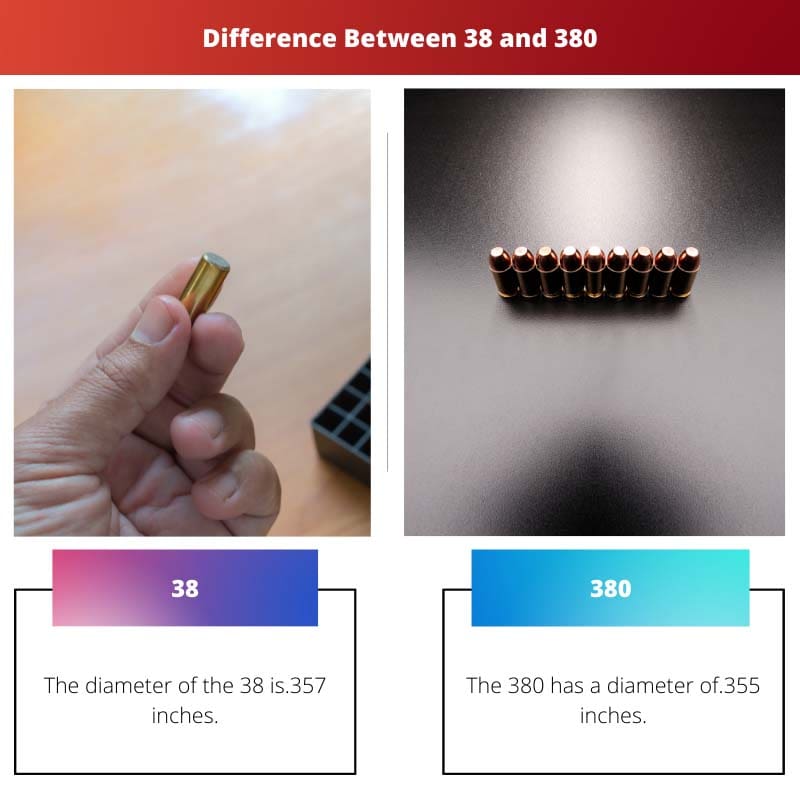Both the 38 and 380 handgun cartridges have been around for almost a century. Both are still widely used in self-defence situations. The two cartridges are not interchangeable despite their similarities.
Anyone interested in these cartridges should be aware of the numerous distinctions between them. Furthermore, during World War I, it was a widely utilized sidearm cartridge.
Key Takeaways
- .38 is a revolver cartridge, while .380 is an auto pistol cartridge.
- .380 has a smaller bullet diameter and lighter bullet weight than .38.
- .38 has a longer case length and higher muzzle energy than .380.
38 vs 380
38 is a type of handgun cartridge that has a bullet diameter of .357 inches, which is used in a variety of handguns, including revolvers and some semi-automatic pistols. 380, a type of handgun cartridge with a bullet diameter of .355 inches. It is commonly used in small, compact firearms.

The 38, known as the 38 Smith & Wesson Special, is a rimmed and straight-walled centerfire cartridge that is frequently employed in revolvers. The 38 is a semi-automatic handgun and carbine cartridge designed by Smith & Wesson.
From the 1920s through the early 1990s, it was the chosen service cartridge of the US police force.
The 380 can’t do anything that the 9mm can’t do better, and you can purchase this at a lower price, too.
Some platforms may have less perceived recoil, but this comes at the expense of terminal performance, magazine capacity, and, in many cases, dependability. Experts attribute this freedom or liberty to the legality of concealed carry.
Comparison Table
| Parameters of Comparison | 38 | 380 |
|---|---|---|
| Bullet Size | The diameter of the 38 is.357 inches. | The 380 has a diameter of.355 inches. |
| Velocity | A bigger 115-grain bullet may be fired at nearly 1,240 feet per second with a 38 cartridge. | A 90-grain bullet can be fired at just over 1,040 feet per second with a 380 cartridge. |
| Energy | 38 bullet moving at 1,240 feet per second would produce about 395 foot-lbs. of energy at the muzzle. | The muzzle energy of a 90-grain bullet fired at 1,040 feet per second by a 380 would be around 215 foot-lbs. |
| Firearms | Only revolvers in 38 calibers. | 380 caliber is used in a variety of semiautomatic handguns. |
| Weight | Bullets in the 38-caliber range in weight from 95 to 158 grams. | The grain weight of 380 is between 85 and 95 grains. |
What is 38?
The 38 calibre, known as the 38 Smith & Wesson Special, is a rimmed and straight-walled centerfire cartridge that is frequently employed in revolvers.
The 38 calibres were developed by Smith & Wesson and are used in a variety of semi-automatic pistols and carbines. From the 1920s through the early 1990s, it was the chosen service cartridge of the US police force.
Furthermore, during World War I, it was a widely utilized sidearm cartridge. It is also known for its metric designation of 9.1x29mmR or 929.5mmR in various areas of the world.
Because of its lethal precision and moderate recoil, the 38 has been around for almost a century and is the most frequently used revolver cartridge in the world.
For self-defence, the destination shot, the competition for professional objectives, and hunting for small games is the selection cartridge.
The “38” in the name refers to the diameter of the loaded brass case, not the cartridge, which measures .357-.358 inches in diameter.
The 38 is comparable to the 38 Long Colt and .357 Magnum but has a differing case length. This implies that a 38-round may be securely used in revolvers chambered in .357 Magnum and 38 Long Colt revolvers chambered in 38. A.357 cartridge.

What is 380?
The 380 is a handgun cartridge with a straight wall casing and no rim. John Moses Browning, an American firearms manufacturer, created the 9x17mm cartridge.
It was originally employed in the Colt Model 1908 pocket hammerless handgun, which was a semi-automatic weapon. The 380 has become a popular self-defence cartridge for numerous smaller pistols all around the world.
Other names for the 380 include the 380, 9x17mm, 9mm short, and 9mm Browning, to mention a few. The 380 should not be confused with the 38 9mm Makarov, 9mm Parabellum, or 9mm Ultra.
The 380 is small and light, but it has less stopping power and a shorter range than other contemporary pistol cartridges. Despite these disadvantages, the 380 is a popular self-defence round.
Individuals who want a compact, lightweight handgun with low recoil appreciate it.
You must carry a 380, and I strongly advise you to use one of the spiral-fluted rounds. I’ve seen and participated in spiral fluted 380 testing and development firsthand, and they are highly suggested.
When shot into ballistic gelatin, these bullets penetrate 10 to 15 inches, whether naked or through four layers of denim, a thick leather jacket, and everything present in between.

Main Differences Between 38 and 380
- The 38 has a diameter of.357 inches. The 380, on the other hand, has a diameter of.355 inches.
- With a 38-cartridge, a larger 115-grain bullet may be shot at approximately 1,240 feet per second. With a 380 cartridge, a 90-grain bullet may be shot at slightly over 1,040 feet per second.
- The muzzle energy of a 90-grain bullet shot at 1,040 feet per second by a 380 would be approximately 215 foot-lbs., but the muzzle energy of a 38 bullet travelling at 1,240 feet per second would be around 395 foot-lbs.
- 38 is Only used in revolvers. In contrast, the 380 calibre is found in a wide range of semiautomatic pistols.
- The weight of 38-caliber bullets varies from 95 to 158 grams. The grain weight of 380, on the other hand, is between 85 and 95 grains.




